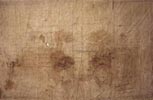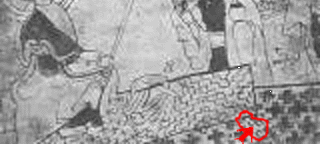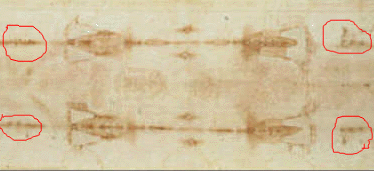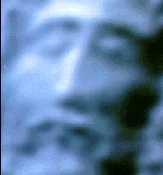![]() La
Misteriosa Sindone di Torino © 2000 Guido Pagliarino
La
Misteriosa Sindone di Torino © 2000 Guido Pagliarino
INDEX OF The Mysterious Shroud of Turin
THE MYSTERIOUS
SHROUD OF TURIN
© 2000 by Guido Pagliarino
[IN SYNTHESIS]
A very short introduction by the Author
I’m a Christian but my Faith is not based on the Shroud of Turin: it’s based, directly, on Christ's Resurrection testified by the Apostles; therefore, this essay essentially has the modest purpose to introduce and examine the Shroud and it does not want to induce the reader to believe to think that the Sheet has wrapped Christ's body or, as commonly said, that it’s authentic; however, I suppose that the affirmative reasons are prevailing: many are the data in favor and only two facts are against and just one of them is objectively considerable: the tests of the carbon 14; however, many experts say that these tests were not convincing; the other adverse reason is the anticlerical prejudice: it’s very strong and leads to consider with nuisance the Shroud without investigating enough the matter.
I wish thank Miss Gloria Filippi for her precious suggestions about the translation from Italian into English of the entire essay.
Guido Pagliarino
Page 1
[The Shroud of Turin before June 20th, 2002]

[The Shroud of Turin after July 22nd, 2002: During the days as from June 20th, 2002 to July 22nd, 2002, Shroud patches and also Holland lining sewed on its back were taken away - Photo © Arcidiocesi di Torino]

The Turin Shroud (Sinḍn in the Gospels' ancient Greek language: it means a funeral cloth, a sheet made of linen and, generally, a sheet, a piece of cloth) - The Holy Shroud for Catholics - is a flax piece of cloth made by a technique ("thorn of fish" ) in use from five thousand to two thousand years ago in Egypt, in Palestine and in other zones of the Middle East. The spinning is "like Z", skewed in sense time, rather than the spinning instead in successive ages "like S", in anticlockwise sense. They are techniques of spinning and weaving of which the Middle Ages have already lost memory. This sheet measures 4,37 meters in length and 1,11 in width.
The Turin Archbishop pro tempore (the archbishop who sits at a certain moment on the Episcopal desk of Turin) is the official caretaker of the Shroud.
Shroud has been in Turin since 1578, with a few occasional absences, usually for wars, as during the French siege at the town of 1706 and, the last time, during the II worldwide conflict: in 1939 (in forecast also Italy, as it happened in 1940, will enter into war) it was moved, in order to repair it from the bombardments, into the Montevergine Sanctuary, near Avellino. It got back in Turin in 1946.
Shroud of Turin, but all people say simply "the Shroud", is still, partially, a mysterious sheet.
It can be observed also by the photo: on the Shroud there are various spots, whose nature and cause partially, not entirely, are notes. As we will see, for a part of these spots the Shroud is like a negative film. On the contrary, for other ones, not: they are positive.
Without doubt...
On this sheet, we find some patches and some signs of burns.
It's sure, by the analyses of experts, invisible deposits of pollens from vegetation of the Middle East, and pollens from flora of the Alps are on the Shroud; moreover, traces of aloe and myrrh; and of aragonite (it's a calcium carbonate, iron and strontium composition), an earth in Jerusalem and, in particular, in a tomb studied by Prof. Levy-Setti, from Chicago: he, confronting with the aragonite on the Shroud, has concluded that the two earths are exactly equal.
It's moreover sure, by analysis made by various pathologists of international reputation, between them we find Prof. Luigi Baima Bollone from Turin, spots of coagulated blood, group AB, male DNA, are on the Shroud
[Sudario - shroud - of Oviedo]

It's curious to know that blood of identical type AB, male, is on the Sudario - shroud - of Oviedo (Spain), one burlap 83x52 centimeters large – Is it the true Veronica's Handkerchief ?! It may be, but in Rome we find another Veronica's holy relic (?) –. These haematic impressions are in symmetrical shapes and recall, in the complex, a human face. Moreover, it's also interesting the following fact about the rests (holy relics) of the miracle (we know by the tradition) happened in the VIIIth century in Lanciano in province of Chieti, Italy (a clergyman had doubted of the presence of Christ in the Eucharist, while he was consecrating, and the bread and the wine were transformed in meat and blood); they are 1) coagulated blood, group AB like the one on the Shroud of Turin; 2) human meat of myocardium: analysis was made in 1970 by Prof. Odoardo Linoli, pathologist. I do not know if the Lanciano Sanctuary manages a Web site.
[Lanciano Sanctuary, holy relics]

On the Shroud of Turin, we find some spots of blood with separate blood serum (it means corpse blood) and some other spots without separation: the last ones come from a person still alive.
It's certain that the cloth has endured burns, by a first fire in a far past time. Most obvious signs of a second one remain: on December 4, 1532, the Shroud chapel in Chambery, Savoy, France, where the sheet was kept, flared up; we may see two burned lines for all the length of the sheet; the Shroud suffered also holes, along these burned lines, but the holes was covered, by patches, by Clare's nuns of a close convent; moreover these nuns sewed, in order to reinforce the sheet, one Holland lining on its back, along all its extension.
It is of all obvious that on this piece of cloth, the images forehead and back of a human body are impressed.
The human image impressed on the Shroud is like one of a negative film. Therefore, impressed photographically on a film, or more anciently on a negative slab, it appears positive as if the Man had been reflected and into this mirror-Shroud his image had been photographed: therefore, as in every negative and for an image into the mirror, what is left appears like right and, on the contrary, the right appears like the left.
In the next page we may see the positive and the negative of a photo of a Byzantine icon and soon, under, we may see the positive and the negative of a photo of the face of the Shroud Man.
|
[Photography of an icon - a human work ] |
[Negative of the same photo] |
|
|
|
|
[Photography of the Shroud Face] |
[Negative of the same photo] |
|
|
|
Those lines that cross hair and beard are two folds of the sheet due to unknown causes; they and the blood spots (as an example, the one, much obvious, on the forehead that has the shape, respective, of a 3 turned upside down on the image to right and of a 3 on that one on the left) on the contrary of the face turn out positive in the right photo and turn out negative in the left one.
We know this sheet (sinḍn) is of the same type used in order to wrap corpses in Palestine at the century of Jesus, even if it was in use, in alternative, wrapping about the dead body bandages like the Egyptians, what we know, also, by the John's Gospel about the corpse of Lazarus from Betània. The dead body was stretched supine on the sheet, with the feet at extremity and with the head towards center of the cloth (to times, on the contrary: the head towards end and the feet towards the center); the other half of the sheet was withdrawn on the corpse that, therefore, remained comprised within the sinḍn.

[In section]
(Shroud) ----------------------------------
(feet) corpse (head) ] (Shroud)
(Shroud) -----------------------------------
Sheet or bandages?
Only Matthew, Mark and Luke, writing about the interment of Jesus, say he was placed in sinḍn, in a sheet. John do not write about a sinḍn (shroud). He talks on the finding of the funeral flaxes of Jesus, the morning of the next Sunday after the Friday of the crucifixion, in the Christ's empty grave: in many translations from ancient Greek into Italian, we find bende (bandages), instead lenzuolo or sindone (sheet).
If one reads the term in ancient Greek, knows that Peter and John found[1] otḥnia and this word means flax fabrics, at the plural in ancient Greek. Therefore, they was not bandages like we find in some translation. Because the term otḥnia means generic flax woven, this word can mean, being plural word, also a sheet between other recovered fabrics; sure it does not mean bandages. The other three Gospels Authors do not tell us the Jesus' Shroud was compound by flax: John wrote after, between the years 90 and 100, and he wanted overwhelm the gap. If John would have spoken about bandages, he would have used not otḥnia but keiŕai (bandages), like we read for revived Lazarus, in the same Book (11 - 44).
About the history of the Shroud
The history of the Shroud from the years 1353-6 is documented without empty periods of time. In the previous centuries, we find above all hypothesis and tradition and very few documents. There is an historical empty space between the year of the crucifixion of Jesus (30 - 33) and the VIth century and there is a nearly empty space from the Costantinopoli’s conquest, by the crusaders in the year 1204, to the years 1353 - 1356:
Only a single document, precisely a nearly document, composed in this period has been found: a miniature in the Pray Code. This religious code is today, since few years, in Budapest; it was composed between the years 1192 - 95, obviously by hand, because it was long time before the discovery in the West World of printing. This miniature represents the Christ's deposition: Jesus do not show the thumbs, they are withdrawn under the palms of the hands; and the same thing we find for the Man on the Shroud of Turin (and we will see because); and like on the Shroud, this miniature represents one of the legs laiding upon the second leg. Moreover, on a sheet painted in the miniature, we may see little circles disposed in a group of a similar shape to one of the four groups, everyone composed by four burned holes that we find on the Shroud of Turin. Truly, on this Shroud they are between some very little circles; however, those large ones immediately appear to the eyes: down below, you may see the photo of one of those groups. The four symmetrical groups of holes are, approximately, in the center of the four rectangles deriving from folding the sheet in four parts. Evidently, when those holes were produced by burn, the Shroud was refolded in four and this fact provoked the lesions passed to all the four layers. The reason of these burns is unknown, but it's known that they are in the cloth before 1532, the year of the fire of the Shroud Chapel in Chambery: these lesions are in fact reproduced on a previous etching attributed to Dürer, realized in the same Chambery in 1516, which reproduces on the Shroud the four symmetrical groups of holes. The author of the miniature of the Pray Code affirms in the text that he was inspired from a shroud. We may suppose he saw the same is conserved today in Turin; and we may suppose the first fire was previous the date of composition of the Pray Code.
[Every bullet indicates a group]

|
[Pray Code] |
[One of the groups of the most ancient burned holes on the Shroud] |
|
|
|
[Magnified particular with evidenced holes]

[Evidenced four holes' groups on the Shroud of Turin -particular -]

But... what about the following fact?
The age of birth of the Shroud has been fixed, by three laboratories, "between
years 1260 and 1390", approximately one/two centuries after the Pray Code. Being
authorized from the Church, in 1988 these laboratories took champions from the
Shroud and in order to establish its seniority they have subjected them to
experiments based on radioactive carbon 14; but only one of the two possible
methods was employed: instead, it would have been necessary to use them both, in
order to be sure. However, several times the two methods presented absurdities
about the results. For example, shells of alive snails were dated at 26.000
years ago. A Viking horn of the 1000 was dated at the XXI century (!). The
Lindow Man was dated, on three samples of its, first time at 300 B.C., second
time at the I century A.D. and third time, at the century V, with a discard of
800 years. About bones and bandages of the same Egyptian mummy, preserved in the
Museum Of Manchester, the first sample turned out to be older of 1000 years than
the second one, while they are contemporary. Here, in this synthesis, I only add
that, from great time, for many reasons, the result of those analyses on the
Shroud is rejected from many scientists, some Christian and some not Christian.
Between these scientists, we find the great searchers Prof. Garza Valdés, Prof.
Moroni, Prof. Bettinelli, Prof. Barbesino and Prof. Koutznezov;
if you know Italian, you may look for
"The
experiments by carbon
14""
![]()
About the human image on the Shroud
According to the analyses of all the experts that studied the Shroud, between the others, Alan Adler, professor of chemistry in the Western Connecticut State University, the human figure isn't produced according to known methods. It's not fruit of a painting, there are not traces of colors: there are not pigments, neither pastes nor colorful powders. The image is not produced by press, inks are not been found.
The image is not even made by singeing the Shroud (approximately it is as it happens when an ignited iron is forgotten over a shirt and a burnt print remains on); this means it's not originated from the contact with a overheated metal relief, because the image by singeing passes from one part to the other part. Image of the Shroud Man is instead most superficial.
The image moreover remains deformed, because the cloth is in contact with a relief, three dimensions, for which the burnt print appearing on the surface of the fabric, two dimensions, is wider of the real one. This is not true for the Shroud: the image is not deformed.
A burnt image has different fluorescence in comparison to the image of the Shroud, and it does not have three-dimensional base; instead, from the Shroud, we could obtain holographic photos of the Man: the first time, in 1977, in USA by Eric J. Jumper and John P. Jackson.
The photographic 3D – three dimensions – is possible if the light received from the object is to different distances from the various parts of the same object. Suppose a luminous source placed in a point of the space, like a lamp: its light must cover less distance in order to reach the nose that is more prominent, and a longer way to reach the mouth, because it's less prominent.
The photo of a painting or, generally, of a bi-dimensional figure cannot turn out three-dimensional, because all its points are on the same plan, at the same distance from the lighting source. This fact demonstrates that the Man of the Shroud is not simple image but something more.
In 1978, a three-dimensional photo of the Face was realized in Turin, Italy, from the team of Prof. Tamburelli.

By electronic procedures cleaning the image of the photography of the Man of the Shroud, without artful manoeuvre and extraneous information, independently from the Americans, the team of professor Tamburelli has reached finally the following holographic image:

Extraordinary!
Then, Prof. Tamburelli and Prof. Balossino have compared the obtained face with those of icons painted between VIth century and the XIIth: they have turned out to correspond to the face of the Shroud for beyond 100 points (according to a particular mathematical calculation), more than are required (minimum 60 points) to consider two faces as those of the same person. The common features confirm the uniqueness of such Jesus's image and they make more probable as much as already to naked eye one may guess: the face of the Shroud had been the prototype of those icons.
Icon of Christ Pantocrator (please, compare it with the face obtained by Prof. Tamburelli)

![]() La
Misteriosa Sindone di Torino © 2000 Guido Pagliarino
La
Misteriosa Sindone di Torino © 2000 Guido Pagliarino
INDEX OF The Mysterious Shroud of Turin
© Guido Pagliarino